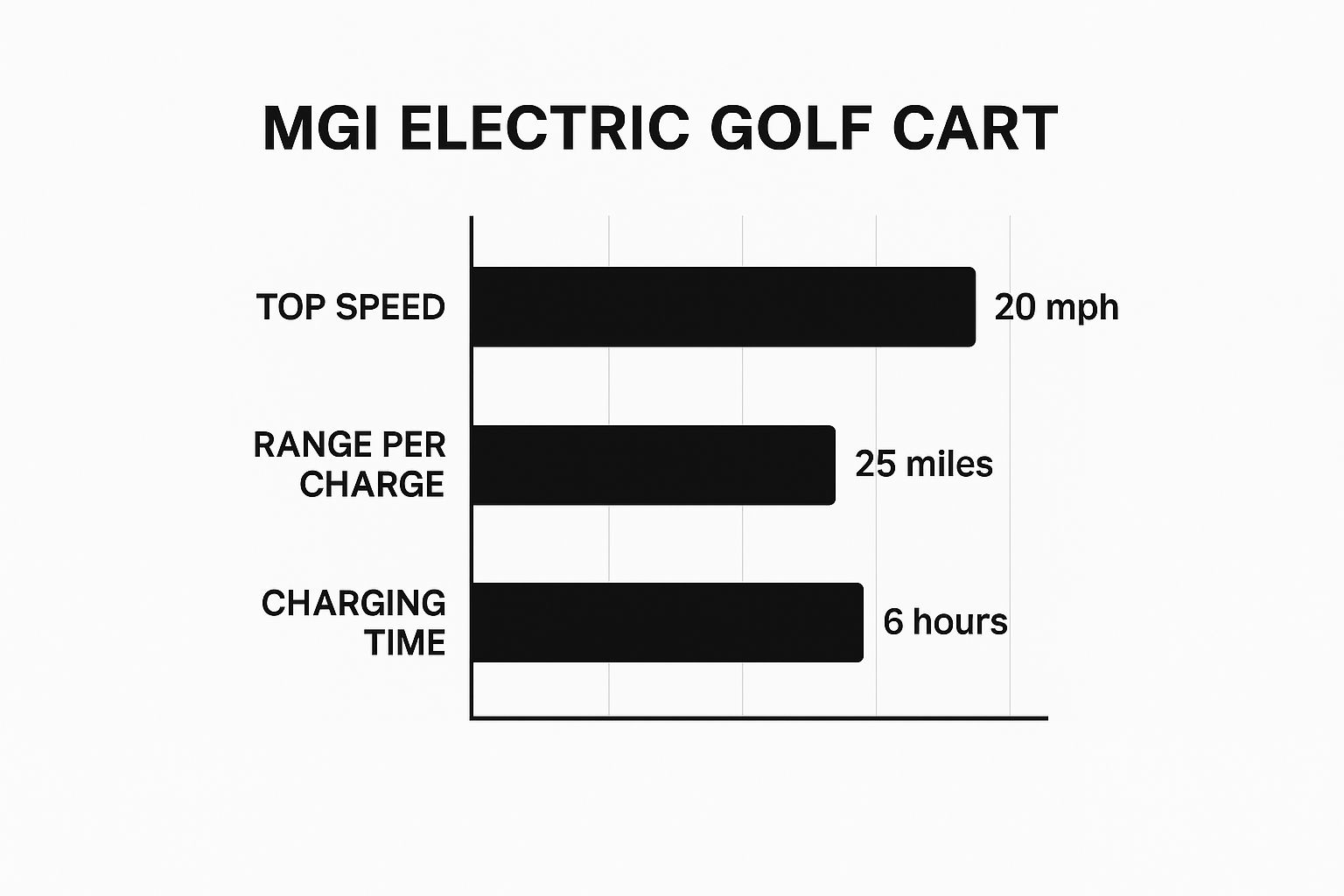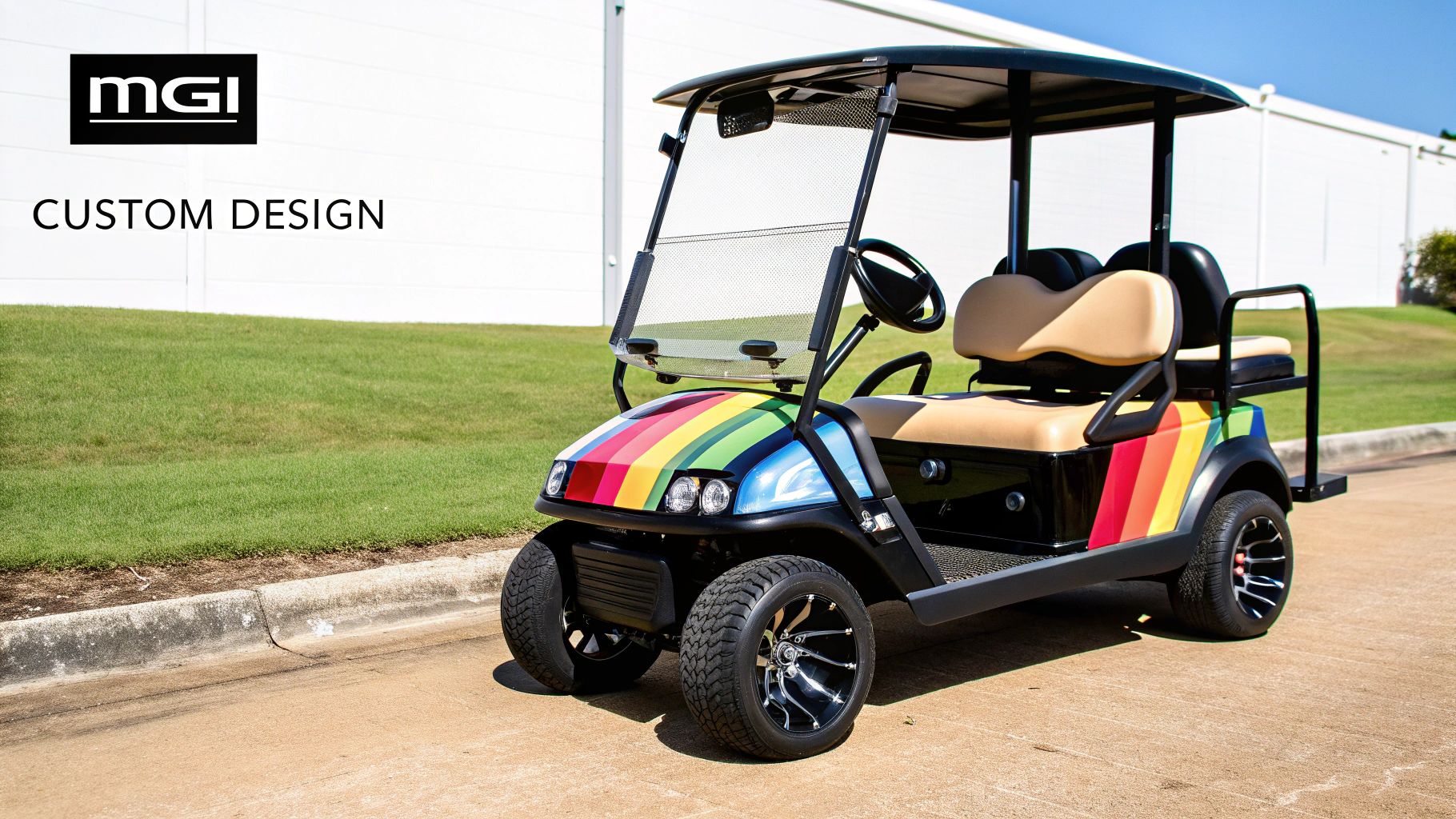Deciding between a fully integrated MGI electric golf cart and a conversion kit like the Caddie Wheel boils down to one simple question: Should you buy a brand-new, feature-loaded system, or just upgrade the push cart you already have? There's no single right answer—it all depends on your budget, your needs, and how you like to play.
Choosing Your Ideal Electric Golf Caddy
For most of us, walking the course is about more than just getting some exercise. It’s part of the strategy, the focus, and the pure enjoyment of the game without getting worn out. An electric caddy is a massive upgrade, but the market gives you two very different ways to get there. The first step is figuring out the real differences between an all-in-one unit and an add-on motor.
An MGI electric golf cart is the all-in-one, premium package. These are purpose-built machines, designed from scratch for perfect performance and often loaded with high-tech features like GPS and full remote control. The Caddie Wheel, on the other hand, is all about flexibility and smart spending. It’s designed to turn the manual push cart you already know and love into a powerful, motorized workhorse.
Defining Your Golfer Profile
To find your best fit, think about which of these sounds most like you:
- The Tech-Focused Player: You’re always looking for an edge and love integrated features that make strategy and convenience seamless.
- The Budget-Conscious Golfer: You want the benefits of an electric caddy without having to buy a whole new piece of gear. Value is your top priority.
- The Practical Upgrader: You’re perfectly happy with your current push cart—its weight, how it folds, its features—and just want to add a motor to it.
This choice is part of a bigger shift in golf. The move to electric is real, with electric models now making up over 70% of the golf cart and buggy market. Valued around USD 2.5 billion in 2022, this market is booming because more golfers want eco-friendly, lower-cost ways to get around the course.
The core decision here isn't just about a feature list; it’s about your philosophy. MGI offers a complete, polished experience out of the box. Caddie Wheel gives you a powerful, smart upgrade for the gear you already trust.
Ultimately, this guide goes way beyond a simple list of specs. We’re going to dive into a detailed, side-by-side breakdown to help you see which option truly fits how you play. By understanding what makes each system tick, you can confidently pick the caddy that will keep you fresh and focused from the first tee to the eighteenth green. If you're just starting your research, our complete guide on everything you need to know before buying an electric golf push cart is a great place to get a handle on the basics.
Understanding Integrated Carts And Conversion Kits

When you’re ready to motorize your golf game, you’ll find yourself at a fork in the road. On one side, you have fully integrated electric carts like the ones from MGI. On the other, you have clever conversion kits like the Caddie Wheel. Getting a handle on this key difference is the first step to figuring out which path is right for you.
An MGI electric golf cart is an all-in-one, purpose-built machine. Everything from the chassis and motor to the battery and remote is engineered from the ground up to work as a single, seamless unit. This approach allows for sophisticated features like built-in GPS, gyroscopic stability, and downhill speed control to be baked right into the experience.
The Caddie Wheel takes a completely different approach. It’s a modular add-on designed to bring electric power to the manual push cart you already have. The philosophy here is all about adaptability and enhancing the gear you know and love, rather than replacing it.
The Integrated Experience
The biggest draw of an integrated system is the out-of-the-box convenience and polished performance. With an MGI cart, there’s no real assembly or installation—you just unfold it, charge it, and go. The manufacturer controls every single element, ensuring the design is perfectly balanced, stable, and intuitive from the first tee.
This is the ideal route for golfers who want a premium, no-fuss experience loaded with the latest tech. Take the MGI Zip Navigator AT, for example. It’s built with beefy all-terrain wheels and powerful downhill braking, features that are deeply woven into its DNA for tackling tough courses. It’s all designed to work as one cohesive unit, giving you a predictable and polished performance every single round.
The Flexible Conversion
The Caddie Wheel offers a different kind of value: empowerment through flexibility. Its design recognizes that a lot of us are already perfectly happy with our push cart’s storage, folded size, and overall feel. The kit simply adds the one thing that's missing—a strong, dependable motor.
This modularity means you aren’t locked into one piece of hardware. If you get a new push cart down the road, the Caddie Wheel can most likely move right along with you, as long as the new cart is compatible. It’s a practical solution for the golfer who wants the physical benefits of an electric caddy without ditching a perfectly good piece of equipment. You can dig deeper into why electric push cart conversion kits offer a green alternative for golfers and see how this approach champions both sustainability and smart value.
MGI's design philosophy is rooted in creating a complete, effortless user experience from day one. Caddie Wheel's commitment is to provide powerful, adaptable performance that enhances the gear you already trust.
Ultimately, the choice comes down to what you prioritize. Do you want a turnkey solution where every feature is perfectly integrated by the manufacturer? Or do you value the flexibility to motorize the specific push cart that’s already a trusted part of your game? This fundamental difference in philosophy is what really drives all the other comparisons we’re about to explore.
Analyzing On-Course Performance And Features
When you're out on the course, the raw performance of your equipment directly impacts your game, from your energy levels to your focus. This is where the technical differences between an integrated MGI electric golf cart and a modular Caddie Wheel truly come to life. Let’s break down how their specs translate into real-world advantages.
The growth in electric caddy technology reflects a much larger trend. The overall golf cart market has already shot past USD 2.6 billion, with electric models making up over 63% of that share. This shift is all about sustainability and efficiency, as electric carts produce zero emissions and usually need less maintenance than their gas-powered cousins. You can dig into more data on this expanding market by checking out the full research on golf cart market trends.
This chart gives you a quick snapshot of the key performance metrics you can expect from a typical MGI electric golf cart.

It really highlights the robust capabilities engineered into these carts, striking a nice balance of speed, impressive range, and manageable charging times.
Let's get into a more direct comparison of the nitty-gritty details.
MGI Electric Golf Cart vs Caddie Wheel Specification Showdown
To really see where these two options stand, a side-by-side look at their core specs is essential. The table below pits a typical MGI model against the Caddie Wheel conversion kit, giving you a clear picture of what each brings to the fairway.
| Feature | MGI Electric Golf Cart (Example Model) | Caddie Wheel Conversion Kit |
|---|---|---|
| Motor System | Integrated twin 230W calibrated motors | Single high-torque motor |
| Battery Type | Lithium 24V 250-380Wh | High-capacity 29.2V lithium-ion |
| Typical Range | 18-36 holes | Up to 36 holes |
| Control System | Full-function remote control, some with GPS | Simple remote (forward, reverse, speed) |
| Key Tech Features | Downhill speed control, gyroscopic tracking | Core power-assist functionality |
| Weight (added to setup) | Varies by model (fully integrated) | Approx. 12 lbs (motor and battery) |
| Hill-Climbing | Excellent, designed for steep inclines | Very good, dependent on push cart |
| Compatibility | N/A (Complete, all-in-one system) | Universal fit for most push carts |
As you can see, the MGI is an all-in-one powerhouse built from the ground up for performance, while the Caddie Wheel delivers impressive power and range in a flexible, universal package.
Motor Power And Hill-Climbing Ability
An electric caddy's real test is its ability to conquer hills without slowing down or tipping. This is where the different engineering philosophies of MGI and Caddie Wheel become obvious.
An MGI electric golf cart, like their Zip Navigator AT, is built with a powerful, integrated dual-motor system. These motors aren't just dropped in; they're specifically calibrated to the cart's weight, balance, and all-terrain wheels. This holistic design results in fantastic hill-climbing torque and stability, especially on steep or uneven ground.
The Caddie Wheel, on the other hand, provides a gutsy single-motor solution designed for broad compatibility. While its motor delivers plenty of power for most moderate hills, its performance is naturally tied to the push cart it’s attached to. The weight distribution, wheel size, and frame of your specific push cart all play a role. For most courses, it's more than enough, but on exceptionally hilly terrain, an integrated system like MGI’s will feel more planted.
Battery Endurance And Charging
Nothing ruins a great round faster than a dead battery. Both systems prioritize endurance, but their approaches and expected performance differ slightly based on their design.
MGI carts typically come with high-capacity lithium-ion batteries engineered to last 18 to 36 holes on a single charge. Because the battery is designed as part of a complete system, its output is optimized for the power draw of the motors and onboard tech. This means you get reliable, predictable performance, round after round.
The Caddie Wheel also features a high-capacity battery that can power a cart for up to 36 holes. Its efficiency is remarkable since it only has to power a single, lightweight wheel. The main consideration here is that battery life can vary a bit more depending on the weight of your golf bag and the rolling resistance of your push cart. Both systems offer straightforward charging, but MGI's integrated battery housing often feels a little more seamless.
Advanced Onboard Technology
This is where an MGI electric golf cart really pulls away from the pack. Models like the Zip Navigator are loaded with advanced tech that you simply won't find in a conversion kit.
- Full Remote Control: MGI offers gyroscopic "straight tracker" technology, letting you confidently send your cart ahead to the next tee with precise control.
- GPS Integration: Some models come with built-in GPS, giving you distances to the front, middle, and back of the green right on the handle's screen.
- Downhill Speed Control: This is a huge safety feature. It automatically manages the cart's speed on steep descents, preventing it from getting away from you.
The Caddie Wheel focuses on doing the core job exceptionally well. It provides a simple, reliable remote for forward, reverse, and speed control. It intentionally avoids complex systems to maintain its universal appeal and keep the price down.
The choice here is pretty clear. If you’re a tech-savvy golfer who wants every possible feature integrated into one device, an MGI cart is the obvious pick. If you just want to stop pushing your cart and prefer a straightforward, no-frills control system, the Caddie Wheel delivers exactly what you need.
Evaluating Daily Use And Portability

Beyond the tech specs and on-course performance, how your electric caddy fits into your daily routine is what really matters. This is where we shift from how it plays to how it lives with you—from setup and storage to just getting it from your car to the first tee. The user journey for an all-in-one system versus a conversion kit is fundamentally different, and nailing this down is key to making the right call.
An MGI electric golf cart is all about instant gratification. Its biggest selling point is convenience right out of the box. You just unfold it, strap on your bag, and you’re off. The folding mechanisms are built to be intuitive, often collapsing the whole unit into a compact shape in just a few quick moves. That seamless experience is a core part of its appeal.
The Caddie Wheel, on the other hand, starts its journey with a one-time installation. It’s designed to be simple, but it does ask for a little bit of effort upfront.
Understanding The Initial Setup
The very first interaction you have with your caddy sets the tone for your long-term ownership. For MGI users, it’s a quick unfold. For Caddie Wheel owners, a small investment of time at the beginning unlocks a ton of flexibility down the road.
- MGI Electric Golf Cart: The "setup" is really just a daily routine of unfolding it. These carts are engineered for speed, with many models boasting one or two-step folding systems that feel like second nature after a round or two.
- Caddie Wheel: Installation means attaching a custom bracket to your push cart’s axle. This usually requires a simple tool like a wrench and can be done in under an hour. Once that bracket is on, clipping the motorized wheel on and off takes just seconds.
This initial difference is a crucial point. It really highlights the opposing philosophies behind each product.
MGI delivers immediate, day-to-day convenience, while Caddie Wheel requires an initial setup for long-term adaptability.
Once that first step is done for the Caddie Wheel, the daily process is just as quick as any integrated cart. But that first installation is a step that all-in-one systems skip entirely.
Comparing Portability And Storage
How easily your caddy fits into your car—and your life—is a huge consideration. Here, we're looking at the practical side of hauling and stashing each option, which can be a deal-breaker for golfers with limited space.
A typical MGI electric golf cart is a single, cohesive unit. When it’s folded, it's designed to be as compact as possible, but you're still wrangling the entire cart—frame, wheels, and all. Their weight can be a factor, especially when you’re lifting it in and out of a trunk. If you have a smaller car, you’ll definitely want to double-check the folded dimensions to make sure it fits.
The Caddie Wheel brings a different kind of portability to the table. Since the motor and battery are housed in a single wheel unit that pops off the push cart, you can break the whole system down into smaller, more manageable pieces.
Portability Breakdown:
- Weight Management: With the Caddie Wheel, you can lift the push cart frame and the motorized wheel into your car separately. This splits the total weight, making each piece lighter and easier to handle. It's a massive benefit for golfers who might struggle with lifting a heavier, single-unit cart.
- Storage Flexibility: Being able to detach the Caddie Wheel means you can store the parts in different spots. The push cart can go where it always has, while the compact wheel unit can be tucked away somewhere else. This offers far more versatile storage solutions in a packed garage or locker.
For golfers with chronic back issues or anyone who just wants to avoid heaving a single heavy object, the modular design of the Caddie Wheel offers a clear advantage in daily handling. On the flip side, those who prefer the simplicity of an all-in-one package will likely find the MGI more their speed, as long as they're comfortable with its total weight and folded size.
Breaking Down The Total Cost Of Ownership
When you're deciding on new golf gear, the sticker price is only the beginning of the story. To really understand the financial side of an MGI electric golf cart versus a Caddie Wheel conversion kit, you have to look at the total cost of ownership. This shows you the true value of your investment over the long haul.
A brand-new MGI cart comes with a higher upfront cost, and for good reason—it's a complete, all-in-one system. Prices scale up across their lineup, from more basic models to premium ones packed with features like GPS and sophisticated remote controls. You're buying the whole package from day one: the frame, motor, battery, and all the integrated tech.
On the other hand, the Caddie Wheel's cost is a bit more flexible. The conversion kit itself is priced much lower, but your total initial investment really depends on what gear you already have in your garage.
Calculating Your True Initial Outlay
The financial picture for a Caddie Wheel user can shift dramatically based on one simple question: do you already own a push cart?
- For Existing Push Cart Owners: Your only cost is the Caddie Wheel kit itself. This makes it an incredibly affordable entry point into the world of electric caddies since you're just upgrading equipment you already own and love.
- For Golfers Starting Fresh: If you need to buy a push cart to go along with the Caddie Wheel, your total initial cost will be the price of both items combined. Even then, this total is often competitive with—or even less than—many fully integrated electric carts on the market.
This flexibility is a huge financial advantage for so many golfers. It lets you motorize your game without making your current push cart obsolete, which can save you hundreds of dollars right out of the gate.
Assessing Long-Term Value And Ongoing Costs
True value is measured over years, not just on the day you buy. Things like warranty, maintenance, and even potential resale value all play a part in figuring out which option makes more financial sense over time. An MGI electric golf cart includes a manufacturer's warranty that covers the entire unit, which definitely offers peace of mind. However, if you need specialized accessories or replacement parts—like unique wheels or electronic boards—you'll have to get them directly from MGI.
The Caddie Wheel offers a different kind of long-term security. The motorized components come with their own solid warranty. The real hidden benefit, though, is that it's attached to a standard push cart. If a non-motorized part breaks, like a simple strap or a piece of the frame, you can usually find generic, inexpensive replacements just about anywhere.
The MGI electric golf cart gives you the security of a single, comprehensive warranty. The Caddie Wheel, however, provides financial resilience with its modular design, separating the high-tech motor from the simple, easily serviceable push cart frame.
This difference also affects what your gear is worth down the road. An MGI cart holds its value well as a complete, premium unit. The Caddie Wheel, being detachable, lets you sell the push cart and the motor separately, which could open you up to a wider pool of potential buyers.
The global market for electric golf carts was valued at around USD 1.7 billion and is expected to keep growing, which shows just how strong the demand is. Fleet programs, like those from MGI Golf, prove how cost-effective these caddies are, with rental prices often breaking down to just a few dollars per round. This trend highlights the value and efficiency these devices bring to the game. You can dig deeper into market trends and learn more about electric golf cart industry growth to see where the investment landscape is headed.
Which Electric Caddy Fits Your Game

So, which one is it? A fully-loaded MGI electric cart or the clever Caddie Wheel conversion kit? Truthfully, there’s no single "winner." The right choice comes down to you—your game, your budget, and how you like to spend your time on the course.
Think of it less as a competition and more as matching the right tool to the right golfer. Let's move past the specs and look at a few real-world scenarios to see where each one truly shines. This will help you see exactly which path is the right one for you.
The Tech-Savvy Golfer
If you're the kind of player who loves having the latest gadgets and wants an all-in-one, seamless experience, the MGI electric golf cart is calling your name. You don’t just want a motor to carry your clubs; you want a smart caddy that gives you a genuine edge.
An MGI delivers exactly that. We’re talking about integrated GPS for pinpoint yardages, gyroscopic tracking to keep it rolling straight, and automated downhill braking for total control on hilly courses. The entire machine is built from the ground up to work in perfect harmony.
If your idea of a perfect round includes sending your cart to the next tee while you line up a putt, all while having every piece of course data at your fingertips, then the premium, integrated experience of an MGI is a perfect match.
The Practical Upgrader
This golfer already owns a push cart they love. They know its quirks, appreciate how it folds up just right to fit in the car, and have all the storage compartments organized. The only thing they'd change is having to push it for 18 holes.
The Caddie Wheel was made for this exact person. It’s a powerful and cost-effective way to motorize the gear you already trust without having to start from scratch. The one-time installation keeps everything you love about your current cart but adds the massive benefit of electric power. It’s the smartest way to upgrade what you’ve got.
The Budget-Conscious Player
For the golfer who is all about getting the most bang for their buck, the Caddie Wheel is an incredibly smart and accessible entry into the world of electric caddies. This player wants the core benefit—no more pushing—without the premium price that comes with a brand-new, fully integrated unit.
The Caddie Wheel’s lower upfront cost is its biggest draw. If you already have a compatible push cart, the investment is minimal. Even if you're starting fresh, buying a new push cart and adding a Caddie Wheel kit often costs significantly less than even a base model MGI cart. It delivers the essential function you're after without all the expensive extras, making it a brilliant financial decision.
To see how it compares to other options on the market, check out our guide on the top golf electric walking carts of 2025.
Got Questions? We’ve Got Answers.
When you're weighing an all-in-one system against a conversion kit, a few questions always pop up. Let's clear the air on the big ones so you can feel confident you're making the right call for your game.
How Tough Is The Caddie Wheel Installation?
Getting the Caddie Wheel set up is a simple, one-and-done job. Most golfers have it done in under an hour with just a basic wrench.
You’ll attach a custom bracket to your push cart’s axle. Once that’s on, the motorized wheel clicks into place in just seconds. It’s designed to be dead simple.
Will The Battery Really Last For 36 Holes?
Both the MGI electric golf cart and the Caddie Wheel are built to go the distance, easily lasting up to 36 holes on a single charge. Of course, the real world throws a few curveballs. Hilly courses and a bag packed to the brim will make either system work harder, which can impact the total range.
For the vast majority of golfers, one charge is plenty for two full rounds. If your home course is a monster with extreme hills, you might want to top it off between rounds just to be safe.
Is The MGI Remote Control Worth The Extra Cash?
This really comes down to how you play. The big selling point for the MGI remote is its gyroscopic "straight tracker" tech, which lets you confidently send your cart off to the next tee on its own. It's a pretty slick feature.
If that level of set-it-and-forget-it convenience sounds like a game-changer for you, then the premium price is likely worth it. But if you just want a reliable remote to manage your speed and direction without any fuss, the Caddie Wheel’s simpler system gets the job done perfectly—without the extra complexity or cost. It delivers exactly what you need.
Ready to give the push cart you already love a serious upgrade? See how the power and simplicity of the Caddie Wheel can transform your walk. Explore Caddie Wheel and make every round more enjoyable.


Share:
Top Cell Phone Holder for Golf Cart – Secure & Easy to Use
Your Guide to the Electric Golf Caddy